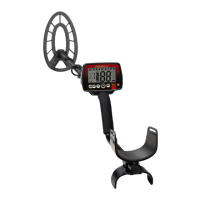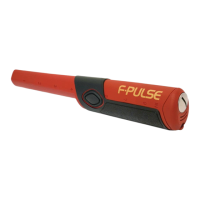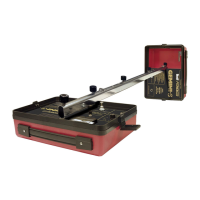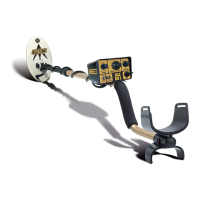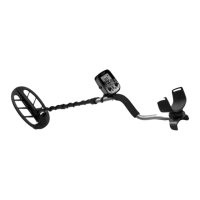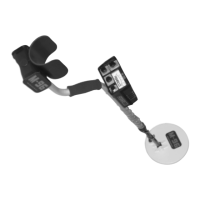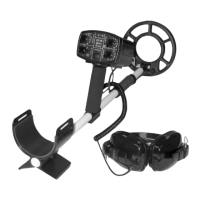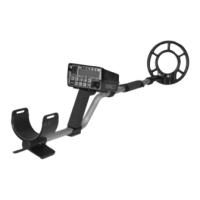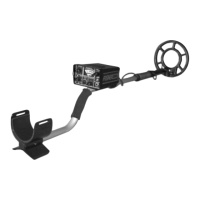1114
4-TONE AUDIO SYSTEM
While the LCD (Liquid Crystal Display) is very accurate in identifying buried
objects, the user in the field does not always maintain the display screen in
his field of vision. Therefore, we have incorporated an audio feedback
mechanism to alert the user to the nature of buried objects. This audio
feedback system first alerts the user to the presence and classification of
objects, whose nature and location can be confirmed using the LCD
display.
The 4-tone audio Target Identification system functions only in the motion
modes of operation. The detector must be in the DISCRIMINATION Mode, as
indicated on the display. In PINPOINT or AUTOTUNE Modes, the detector will
emit only a monotone sound.
The detector can sound four different tones, depending on the object detected.
LOW TONE
Ferrous objects, such as iron and steel, will induce a low tone.
The smallest gold objects can also induce a low tone.
LOW-MID
Pull-Tabs, nickels & smaller gold
MEDIUM TONE
Newer pennies (post-1982), larger gold objects, zinc, and small brass
objects, will induce medium tones. Many recent vintage non-U.S.
currencies will induce medium tones.
HIGH TONE
Silver and copper coins, larger brass objects and older pennies (pre-
1982), will induce high tones. Quarters, dimes and other precious
coins fall into this category.
Audio Target Identification (ATI) classifies metals into four categories.
LOW TONE
Nails, Iron Objects,
& Smallest Gold Objects
LOW-MID TONE
Pull Tabs, Nickels,
& Smaller Gold
MEDIUM TONE
Zinc Pennies (Post 1982),
Larger Gold Objects
HIGH TONE
Copper, Silver & Brass
Copper Pennies (Pre 1982)
CONTROL PANEL
(continued)
As you sweep the searchcoil over a metal object, a numeric target
identification will appear in the center of the display. At the same time, the
bar graph on the left of the display will indicate the target depth, in inches.
See the scale printed on label to left of the bar graph. This scale is calibrated
to coin-sized objects. If the target is larger than a coin, it can be used to
approximate relative target depth.
NOTCH
This control allows you to selectively include or exclude target categories
from detection. The NOTCH control can be invoked from any search mode.
After selecting the categories to notch-in or notch-out, the detector will
always return to the motion discrimination mode.
Notching functions in two ways, manual or automatic.
MANUAL NOTCH
If no target arrows are visible, pressing the NOTCH pad will display an “R”
under all target categories currently eliminated and the “s ” under Iron1
will flash.
Use the
Discrimination
+
or
– pads to move the position of the flashing
“s ”. Pressing NOTCH a 2nd time will change the state of the “R” under
the flashing “s ”; if the “R” was previously illuminated, it will disappear.
Conversely, if the “R” was not illuminated, a 2nd press of the NOTCH pad
will illuminate the “R”, causing this category to be eliminated from
detection.
Practice by pressing the NOTCH pad in conjunction with the
Discrimination
+
and
– pads;
their function will quickly
become obvious.
AUTOMATIC NOTCH
If a target has just been
detected and a target arrow is
visible, pressing NOTCH will
immediately illuminate a
flashing “s ” under this
category.
Press NOTCH a 2nd time to
eliminate that target category
from detection.
This Automatic Notch feature is
a convenient way to quickly eliminate the most recently detected target
from future detection.
F4manual-SPREADS(24pg).qx_MF4B-F4manual 4/2/15 12:29 PM Page 11
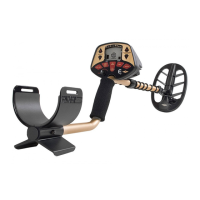
